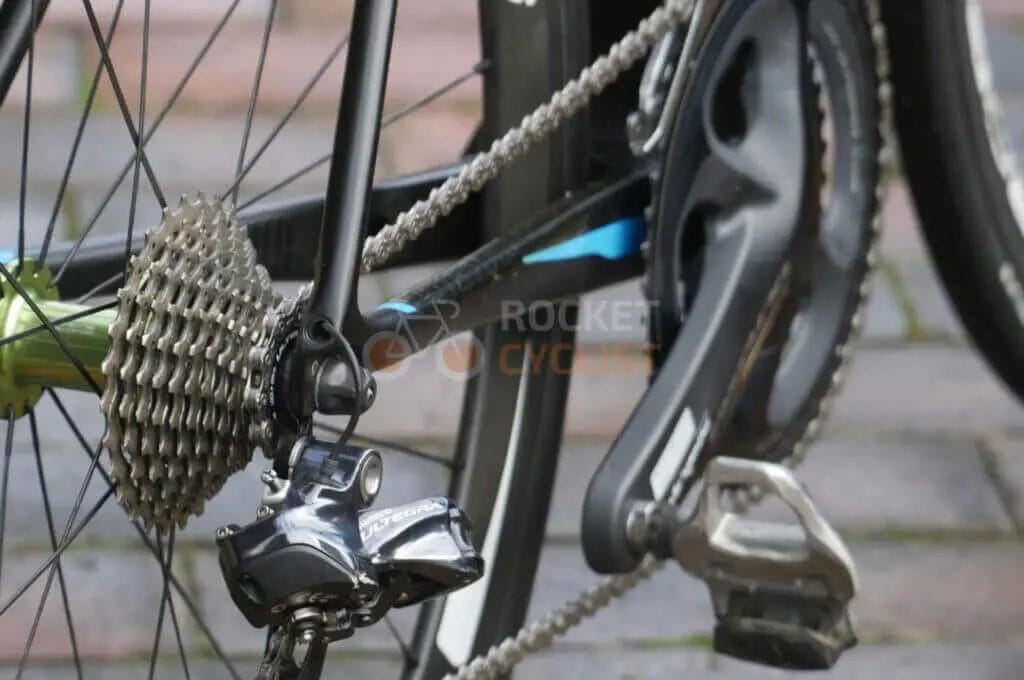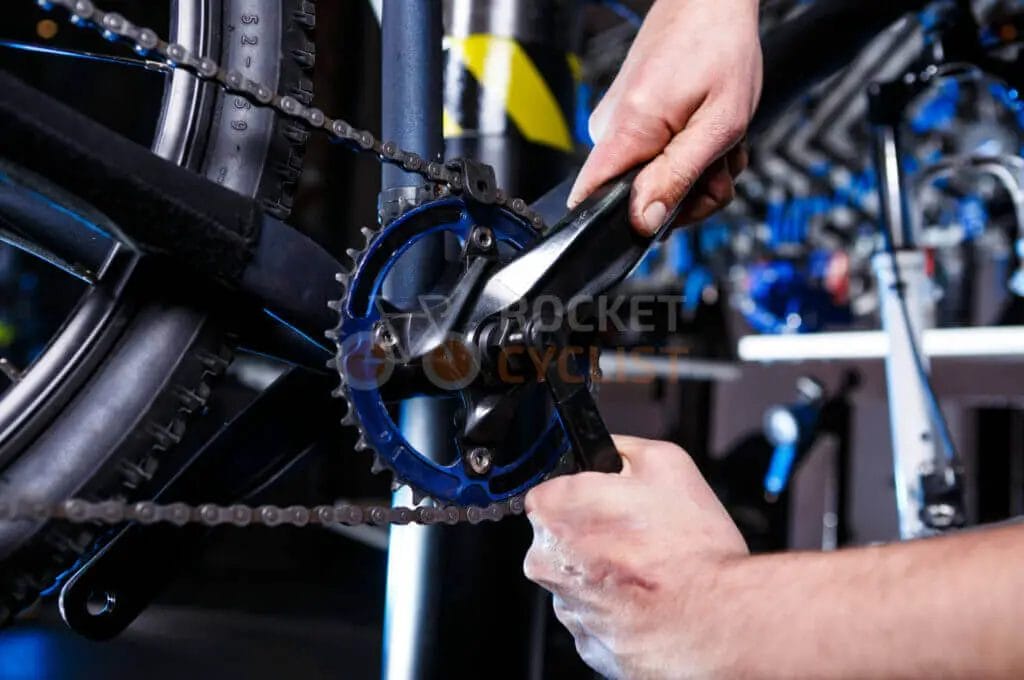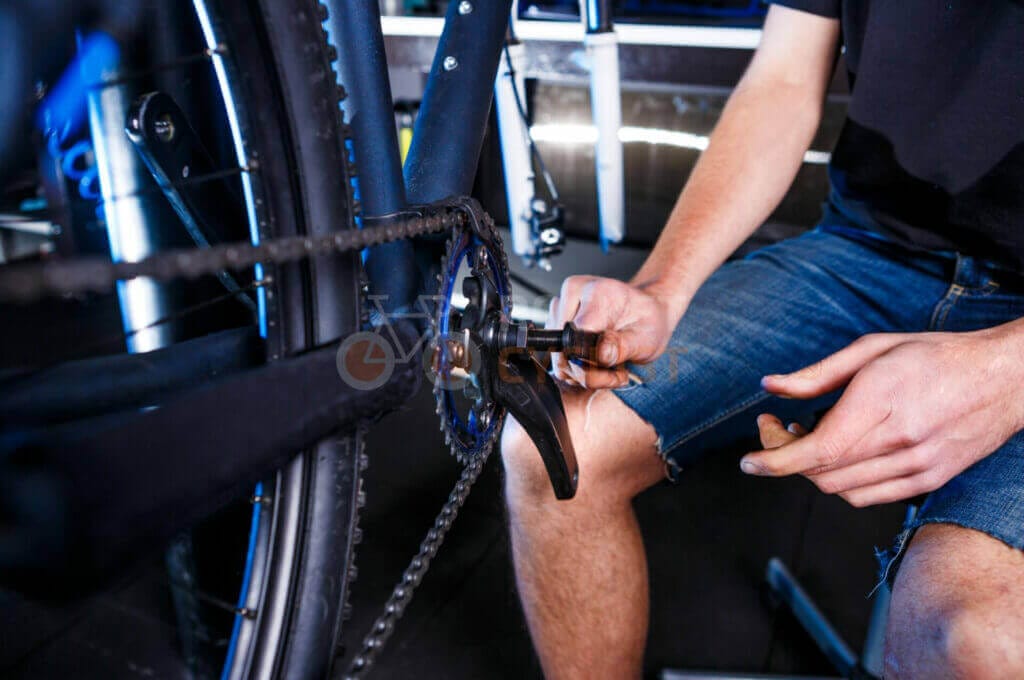Last Updated on March 31, 2024 by Vinson Lozano
Importance of Bike Chainrings
Bike chainrings are a critical component of a bicycle’s drivetrain system. They are the toothed rings that connect to the crankset and engage with the bike chain to transfer power from the rider’s legs to the wheels.
The size and number of teeth on the chainrings determine the gearing ratio and ultimately affect how easy or hard it is to pedal the bike.
Factors affecting the lifespan of Bike Chainrings

There are several factors that can influence the lifespan of bike chainrings:
1. Material: The material composition of the chainrings can impact their durability. High-quality chainrings are typically made from materials such as aluminum, carbon fiber, or steel, which are more resistant to wear and tear.
2. Riding style and conditions: Aggressive riding styles such as frequent standing and pedaling at high torque or riding in muddy or gritty conditions can accelerate the wear on chainrings. Riding in wet conditions without proper maintenance can also lead to rust and corrosion, further impacting the lifespan of the chainrings.
3. Maintenance: Regular cleaning, lubrication, and proper chain maintenance are essential for prolonging the lifespan of the chainrings. Neglecting these maintenance tasks can result in increased friction and wear on the chainrings.
4. Mileage: The amount of mileage and frequency of riding also play a role in the lifespan of the chainrings. Heavy usage over time can cause the teeth of the chainrings to wear down, affecting performance and shifting accuracy.
While there is no set lifespan for bike chainrings, they are generally designed to last for several thousand miles of riding. However, it is important to regularly inspect and maintain the chainrings to ensure optimal performance and longevity.
By following proper maintenance practices and being mindful of the factors that can affect their lifespan, cyclists can maximize the durability of their bike chainrings.
Average Lifespan of Bike Chainrings

When it comes to the lifespan of bike chainrings, several factors come into play. Here are some key points to consider:
Normal Wear and Tear
The average lifespan of bike chainrings varies depending on various factors, including the quality of the chainrings, quality of the drivetrain components, riding conditions, and maintenance practices.
In general, bike chainrings can last anywhere from 2,000 to 10,000 miles, with some high-quality chainrings lasting even longer. However, it’s important to note that chainrings can wear out faster if subjected to harsh riding conditions or lack of maintenance.
Maintenance and Cleaning
Proper maintenance and cleaning can significantly extend the lifespan of bike chainrings. Here are some maintenance tips to consider:
- Regularly clean and lubricate the chain and chainrings to prevent dirt, grime, and rust buildup. This helps reduce friction and wear on the chainrings.
- Check for any signs of wear or damage regularly. Inspect the teeth of the chainrings for signs of wear, such as hooking or shark finning. If you notice any significant wear, it may be time to replace the chainrings.
- Regularly replace the chain to prevent excess wear on the chainrings. A stretched or worn-out chain can put additional stress on the chainrings, leading to premature wear.
- Avoid cross-chaining, which is when you use extreme gear combinations that put a lot of strain on the chainrings. This can accelerate wear and lead to premature failure.
By following these maintenance practices, you can help prolong the lifespan of your bike chainrings and ensure a smoother and more reliable ride. Remember to consult your bike’s manufacturer recommendations and seek professional assistance if you’re unsure about the condition of your chainrings.
Signs of Wear on Bike Chainrings

Teeth Shape and Condition
One of the telltale signs that your bike chainrings may need replacing is the shape and condition of the teeth. Over time, the teeth on the chainrings can become worn down or hooked, which can affect the performance and smoothness of your gear changes. Here are some indicators that your chainrings may be worn:
- Reduced tooth height: If the teeth on your chainrings appear shorter or seem to have worn down, it’s a sign that they have reached the end of their lifespan. Worn teeth can impact shifting efficiency and may cause the chain to slip or skip.
- Hooked or shark tooth appearance: When the teeth on chainrings become hooked or develop a shark tooth-like shape, it indicates that they are worn and need replacing. This can lead to poor shifting performance and potential chain derailment.
Chain Skips or Jumps
Another sign that your bike chainrings may be worn out is when your chain skips or jumps while pedaling. If you notice that your chain is slipping or shifting unexpectedly, it could be due to worn chainrings. Here are some signs of chain skips or jumps:
- Inconsistent gear shifting: If your chain jumps between gears or struggles to stay in the desired gear, it could be a sign of worn chainrings. This can affect your overall riding experience and hinder your cycling performance.
- Chain slipping under load: If your chain slips or skips when you apply pressure to the pedals, especially when climbing or accelerating, it’s an indication that the chainrings are worn and not providing adequate grip on the chain.
If you experience any of these symptoms, it’s important to inspect your chainrings and consider replacing them if necessary. Regular maintenance and inspection of your bike’s drivetrain components will ensure optimal performance and help prevent premature wear and costly repairs.
Extending the Lifespan of Bike Chainrings

Proper Chain Maintenance
To prolong the lifespan of your bike chainrings, it’s essential to practice proper chain maintenance. By following these tips, you can ensure that your chainrings stay in good condition for longer:
1. Clean and Lubricate: Regularly clean your chain and apply lubricant to keep it running smoothly. This helps prevent dirt and grime buildup, which can accelerate wear and tear on your chainrings.
2. Proper Tension: Check the tension of your chain regularly. If it’s too loose, it can cause excessive wear on your chainrings. Use a chain tension gauge or consult your bike’s user manual for the correct tension specifications.
3. Avoid Cross-Chaining: Cross-chaining refers to using extreme gear combinations, such as the big chainring with the big rear cog or the small chainring with the small rear cog. This puts unnecessary stress on your chainrings and can cause premature wear. Try to avoid cross-chaining whenever possible.
Regular Inspections and Replacements
Even with proper maintenance, bike chainrings will eventually wear out and need to be replaced. Here are some signs that indicate it’s time for a replacement:
1. Chain Skipping: If your chain starts skipping or slipping under load, it could be a sign of worn-out chainrings. In this case, it’s best to replace both the chain and the chainrings at the same time.
2. Chain Wear: Regularly check your chain for wear using a chain wear indicator tool or a ruler. If the chain shows significant wear, it’s likely that your chainrings have also worn out and need to be replaced.
3. Teeth Damage: Inspect your chainrings for signs of tooth wear, such as sharp or hooked teeth. If you notice significant damage, it’s a clear indication that you need new chainrings.
By regularly maintaining your bike chain and keeping an eye out for signs of wear, you can extend the lifespan of your chainrings. Remember to replace worn-out chainrings promptly to ensure optimal performance and avoid potential chain failure during your bike rides.
Upgrading Bike Chainrings

When it comes to bike chainrings, there may come a time when you want to upgrade for various reasons. Whether you’re looking to enhance performance or replace a worn-out chainring, upgrading can be a great way to improve your cycling experience. Here are a few things to consider when upgrading your bike chainrings:
Upgrading to a Higher-Quality Chainring
1. Improved Performance: Upgrading to a higher-quality chainring can often result in improved performance. High-quality chainrings are more precise, which can result in smoother shifting and improved power transfer. This can make a noticeable difference in your riding experience.
2. Durability: Higher-quality chainrings are often made from more durable materials, such as carbon fiber or aluminum alloy. This increased durability can result in a longer-lasting chainring that can withstand more wear and tear over time.
3. Weight Reduction: Many higher-quality chainrings are designed to be lightweight, which can help reduce the overall weight of your bike. A lighter bike can offer advantages in terms of increased speed and maneuverability.
Choosing the Right Chainring Material
When upgrading your chainrings, it’s important to consider the material they are made from. Here are some common materials used in chainring construction:
1. Aluminum Alloy: Aluminum alloy is a popular choice for chainrings due to its lightweight nature and durability. It can provide a good balance of performance and affordability.
2. Carbon Fiber: Carbon fiber chainrings are exceptionally lightweight and offer excellent stiffness. They are often used in high-end performance bikes where weight reduction is a priority. However, they can be more expensive than other materials.
3. Steel: Steel chainrings are known for their durability and affordability. They are commonly used in entry-level and commuter bikes where weight reduction is not a major concern.
Overall, upgrading your bike chainrings can be a worthwhile investment if you’re looking to enhance your cycling experience. Consider factors such as performance, durability, and material when making your decision. Remember to consult with a professional or do thorough research before making any upgrades to ensure compatibility with your bike’s drivetrain.
Conclusion
After analyzing the data and considering various factors, it can be concluded that the lifespan of bike chainrings can vary depending on several variables such as usage frequency, riding conditions, maintenance practices, and the quality of the chainrings themselves.
On average, bike chainrings can last anywhere from 2,000 to 10,000 miles before needing replacement. However, it is important to note that this is just a general estimate, and the actual lifespan can differ from one rider to another.
Tips for maintaining and extending the lifespan of Bike Chainrings
To ensure that your bike chainrings last as long as possible, consider the following tips for maintenance and care:
- Regular Cleaning: Keep your chainrings clean by regularly removing dirt, grime, and debris. Use a degreaser and a brush to clean the chainrings thoroughly, and then dry and lube them properly to prevent rust and corrosion.
- Proper Lubrication: Apply chain lubricant to the chainrings regularly to reduce friction and wear. Make sure to choose a lubricant specifically designed for bike chains.
- Avoid Cross-Chaining: Try to avoid extreme gear combinations that cause excessive strain on the chainrings. This includes riding in the smallest chainring and smallest rear cog, or in the largest chainring and largest rear cog. Cross-chaining can accelerate chainring wear.
- Check for Wear: Regularly inspect your chainrings for signs of wear, such as hooked teeth, sharp edges, or excessive wear on the teeth. If you notice any significant wear, it may be time to replace the chainrings.
- Professional Maintenance: Consider taking your bike to a professional bike shop for regular inspections and maintenance. They can help identify any issues with your chainrings and provide necessary repairs or replacements.
By following these maintenance tips and taking good care of your bike chainrings, you can extend their lifespan and enjoy optimal performance for a longer period of time.


